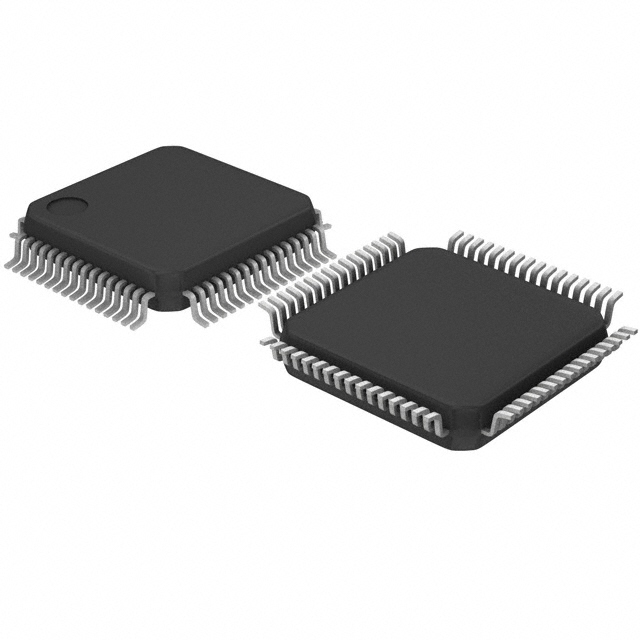MB9AF114LAPMC1-G-JNE2
Basic Information Overview
- Category: Integrated Circuit (IC)
- Use: Microcontroller
- Characteristics: High-performance, low-power consumption
- Package: LQFP (Low-profile Quad Flat Package)
- Essence: Advanced microcontroller for various applications
- Packaging/Quantity: Tray packaging, quantity varies based on order
Specifications
- Manufacturer: Fujitsu Semiconductor Limited
- Model: MB9AF114LAPMC1-G-JNE2
- Architecture: ARM Cortex-M3
- Clock Speed: Up to 72 MHz
- Flash Memory: 256 KB
- RAM: 32 KB
- Operating Voltage: 2.7V - 5.5V
- I/O Pins: 48
- Communication Interfaces: UART, SPI, I2C, USB
- Analog-to-Digital Converter (ADC): 12-bit, 8 channels
- Timers/Counters: 16-bit, 4 channels
- PWM Channels: 6
- Operating Temperature Range: -40°C to +85°C
Detailed Pin Configuration
The MB9AF114LAPMC1-G-JNE2 microcontroller has a total of 48 pins. The pin configuration is as follows:
| Pin Number | Pin Name | Function | |------------|----------|----------| | 1 | VDD | Power Supply (Positive) | | 2 | VSS | Ground (0V) | | 3 | P00 | General Purpose I/O | | 4 | P01 | General Purpose I/O | | ... | ... | ... | | 47 | P46 | General Purpose I/O | | 48 | P47 | General Purpose I/O |
Functional Features
- High-performance ARM Cortex-M3 core for efficient processing
- Low-power consumption for extended battery life
- Rich set of communication interfaces for versatile connectivity options
- Built-in analog-to-digital converter for precise sensor data acquisition
- Timers and counters for accurate timing and event management
- PWM channels for controlling motors and other devices
Advantages and Disadvantages
Advantages: - Powerful processing capabilities - Low power consumption - Versatile communication interfaces - Precise analog-to-digital conversion - Flexible timer and counter functionality
Disadvantages: - Limited flash memory and RAM compared to some other microcontrollers - Relatively higher cost compared to entry-level microcontrollers
Working Principles
The MB9AF114LAPMC1-G-JNE2 microcontroller operates based on the ARM Cortex-M3 architecture. It executes instructions stored in its flash memory, processes data, and controls various peripherals and I/O devices. The microcontroller communicates with external devices through its communication interfaces and interacts with the physical world through its I/O pins.
Detailed Application Field Plans
The MB9AF114LAPMC1-G-JNE2 microcontroller is suitable for a wide range of applications, including but not limited to: - Industrial automation - Consumer electronics - Home appliances - Automotive systems - Internet of Things (IoT) devices
Detailed and Complete Alternative Models
- MB9AF112LAPMC1-G-JNE2: Similar specifications, but with 128 KB flash memory and 16 KB RAM
- MB9AF113LAPMC1-G-JNE2: Similar specifications, but with 192 KB flash memory and 24 KB RAM
- MB9AF115LAPMC1-G-JNE2: Similar specifications, but with 512 KB flash memory and 64 KB RAM
(Note: The above alternative models are just examples and not an exhaustive list.)
This concludes the encyclopedia entry for MB9AF114LAPMC1-G-JNE2, a high-performance microcontroller with various features suitable for diverse applications.
Lista 10 Vanliga frågor och svar relaterade till tillämpningen av MB9AF114LAPMC1-G-JNE2 i tekniska lösningar
Sure! Here are 10 common questions and answers related to the application of MB9AF114LAPMC1-G-JNE2 in technical solutions:
Q1: What is MB9AF114LAPMC1-G-JNE2? A1: MB9AF114LAPMC1-G-JNE2 is a microcontroller unit (MCU) manufactured by Fujitsu. It is designed for use in various technical solutions.
Q2: What are the key features of MB9AF114LAPMC1-G-JNE2? A2: Some key features of MB9AF114LAPMC1-G-JNE2 include a high-performance ARM Cortex-M3 core, multiple communication interfaces, analog-to-digital converters, and a wide range of peripherals.
Q3: What are the typical applications of MB9AF114LAPMC1-G-JNE2? A3: MB9AF114LAPMC1-G-JNE2 can be used in various applications such as industrial automation, consumer electronics, motor control systems, and smart home devices.
Q4: What is the operating voltage range of MB9AF114LAPMC1-G-JNE2? A4: The operating voltage range of MB9AF114LAPMC1-G-JNE2 is typically between 2.7V and 5.5V.
Q5: How much flash memory does MB9AF114LAPMC1-G-JNE2 have? A5: MB9AF114LAPMC1-G-JNE2 has a flash memory size of 128KB.
Q6: Can MB9AF114LAPMC1-G-JNE2 be programmed using C/C++? A6: Yes, MB9AF114LAPMC1-G-JNE2 can be programmed using C/C++ programming languages.
Q7: Does MB9AF114LAPMC1-G-JNE2 support real-time operating systems (RTOS)? A7: Yes, MB9AF114LAPMC1-G-JNE2 supports various RTOS options, allowing for efficient multitasking and real-time performance.
Q8: What communication interfaces are available on MB9AF114LAPMC1-G-JNE2? A8: MB9AF114LAPMC1-G-JNE2 provides interfaces such as UART, I2C, SPI, CAN, and USB.
Q9: Can MB9AF114LAPMC1-G-JNE2 be used for motor control applications? A9: Yes, MB9AF114LAPMC1-G-JNE2 offers dedicated features and peripherals for motor control applications, making it suitable for such use cases.
Q10: Is there any development kit available for MB9AF114LAPMC1-G-JNE2? A10: Yes, Fujitsu provides a development kit specifically designed for MB9AF114LAPMC1-G-JNE2, which includes necessary tools and documentation to aid in the development process.
Please note that these answers are general and may vary depending on specific requirements and configurations.


